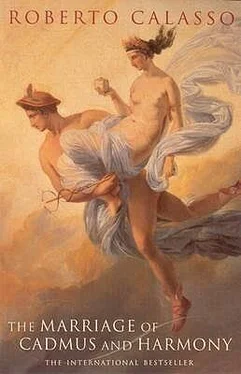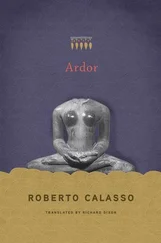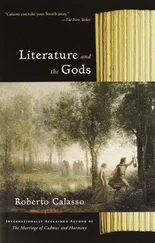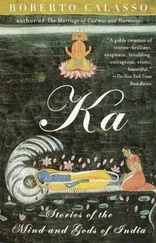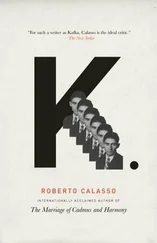Roberto Calasso - The Marriage of Cadmus and Harmony
Здесь есть возможность читать онлайн «Roberto Calasso - The Marriage of Cadmus and Harmony» весь текст электронной книги совершенно бесплатно (целиком полную версию без сокращений). В некоторых случаях можно слушать аудио, скачать через торрент в формате fb2 и присутствует краткое содержание. Год выпуска: 1993, Издательство: Alfred A. Knopf Inc, Жанр: Современная проза, на английском языке. Описание произведения, (предисловие) а так же отзывы посетителей доступны на портале библиотеки ЛибКат.
- Название:The Marriage of Cadmus and Harmony
- Автор:
- Издательство:Alfred A. Knopf Inc
- Жанр:
- Год:1993
- ISBN:нет данных
- Рейтинг книги:3 / 5. Голосов: 1
-
Избранное:Добавить в избранное
- Отзывы:
-
Ваша оценка:
- 60
- 1
- 2
- 3
- 4
- 5
The Marriage of Cadmus and Harmony: краткое содержание, описание и аннотация
Предлагаем к чтению аннотацию, описание, краткое содержание или предисловие (зависит от того, что написал сам автор книги «The Marriage of Cadmus and Harmony»). Если вы не нашли необходимую информацию о книге — напишите в комментариях, мы постараемся отыскать её.
The Marriage of Cadmus and Harmony — читать онлайн бесплатно полную книгу (весь текст) целиком
Ниже представлен текст книги, разбитый по страницам. Система сохранения места последней прочитанной страницы, позволяет с удобством читать онлайн бесплатно книгу «The Marriage of Cadmus and Harmony», без необходимости каждый раз заново искать на чём Вы остановились. Поставьте закладку, и сможете в любой момент перейти на страницу, на которой закончили чтение.
Интервал:
Закладка:
From Iphigenia to the daughters of Erechtheus and the Coronides, it is always a splendid virgin who has to be sacrificed. And the sacrifice is always a pendulum swinging back and forth between suicide and the wedding ceremony. During the year, by which we mean nature in its totality, there are “gloomy and ill-omened days,” when young girls will get their throats cut. For this is the way, the only way men know, to have those girls cross the frontier of the invisible and so meet the divine avengers waiting for them on the other side.
These avengers harbor “frenzied, tyrannical desires” for the girls’ bodies and pester them continuously, but they cannot operate in the visible world to the point of being able “to couple with those bodies and penetrate them.” As a result, we men have to find a way of satisfying this angry impotence of the daímones , and we do it by abandoning the lifeless corpses of the girls along that borderline that passes through the altar. Here lies the origin of every dark eros.
Zeus and Hera had been arguing since time immemorial. Hera decided to hide in Euboea. When a great goddess withdraws and hides, the world soon falls apart. “Destitute and lost,” Zeus looked for her. He wandered all over Boeotia. What could he do? How could he get the goddess out of her hiding place and into the open?
It was a man, Alalcomeneus, who suggested the trick. Zeus must pretend to marry someone else. The other woman must be a block of oak carved in the shape of a girl and draped in veils. Then this rigid bride must be set up on a chariot and taken to her wedding. They called her Daedala, which is as much as to say Artifact, because she was the first creature who embodied art in herself. When the celebrations had begun and the chariot with Zeus’s bashful new bride was already winding through the streets of Plataea, Hera could bear it no longer. She jumped up on the chariot in a rage, looked at her motionless rival, and tore off her wedding veils, meaning to scratch her face to shreds. But then she realized she was looking at a xóanon , one of those endless blocks of wood kept in temples all over Greece. And the goddess laughed. It was a cruel, ringing laugh, a little girl’s laugh. And we owe it to that laugh that the world, at least so far, has not fallen to pieces. But this didn’t occur to the women of Plataea at the time. They saw the goddess set herself at the head of the procession, and they strung along after her. First they helped Hera to bathe the statue like a bride in the river Asopus. Then they followed the chariot as far as a clearing topped by oaks on the summit of Mount Cithaeron. The goddess ordered them to build a big bonfire. She placed the statue with its torn veils in the middle. And all around, on the trunks forming the bonfire, the faithful heaped up their animals. The richest even offered cows and bulls. They poured on wine and incense. Then the goddess set it alight.
The statue was reduced to ashes while the shrieks of the animals being burned alive drowned out the crackling of the flames. Many years later, in the same place, the ceremony was still being performed. Pausanias saw the pyre and said: “I know of no fire so high, nor visible from so far off.”
In what Plutarch called “ancient physiology” and defined as a “discourse on nature entwined in myths,” hierogamy and sacrifice become the two extremes of the respiratory process: air breathed in reaches the blood and nourishes it, becoming unrecognizable in the resulting mix (hierogamy); air breathed out is expelled forever (sacrifice) and mixes with the air of the world. But, even at the point of greatest distance and tension, these extremes were superimposed over each other.
A tall, destructive fire; the penetration of the god in the body of the goddess. Between these two events there turns a hinge: a wooden statue. Hera laughed as she tore the veils from Zeus’s inanimate spouse. But that didn’t mean she gave up the idea of killing her, of burning the statue to bits like a dangerous rival. As for Zeus, if he wants to lure the goddess out of the darkness, he has to add a copy, an image, to the world. Nothing less than that will suffice to create the hinge that will bring the sovereign couple back together again. A tiny wooden fake is brought into the world, draped in veils, and saves it. But then has to be burned. And the image must be draped in veils because it is itself a veil, a surplus, that hides something else. The bride is draped in veils, as discourse is draped in myth. When the veil is torn away, there is nothing but laughter and flames. First for salvation, then for destruction: but the truth is that the two things are simultaneous. It was all part of those “unspoken things” that are scattered throughout every myth and liturgy and that have always seemed “more suspect than the things one speaks about.”
The pagan world was destroyed less by the Christians than by itself. None of the poisoned attacks of the Fathers of the Church had the same destructive power as Alexander or the False Prophet , a pamphlet written by a perfect pagan, Lucian of Samosata. It is an unparalleled portrait of a great impostor, model for a civilization that was to produce impostors in plenty. Did Alexander of Abonuteichos ever really exist? Some jewelry, coins, and inscriptions confirm that he did. Yet, apart from those silent witnesses, the only trace of his life that remains is Lucian’s violent pamphlet attacking him. Should we believe what Lucian says there? It’s hard to say, but the sheer power of literature brushes a question like this aside.
Scornful of anything and everything, Lucian saw in Alexander of Abonuteichos a malignant repeat, an ignominious shadow of that other Alexander, first emperor of the West. Hadn’t Alexander the Great set off to conquer the East like a new Dionysus (the fourth, mythographers would say)? Hadn’t he been the first to insinuate that a sovereign could also be a god? Well, Alexander of Abonuteichos likewise lived and behaved as if he were a god.
Like Alexander the Great, Alexander of Abonuteichos had grown up in the provinces, in Paphlagonia — but then anywhere that wasn’t Athens was the provinces. By the time he died, he was renowned throughout the Roman Empire. As a boy, Alexander of Abonuteichos was extremely handsome, with a clear complexion, a soft beard, and long hair — and if the last wasn’t all his own, nobody noticed. “His eyes shone with a divine and compelling enthusiasm.” His voice was clear and gentle. He was an amazingly fast thinker. It seemed there was no quality he didn’t have. “In fact, on first meeting, all without exception would go away with the impression that they had spoken to the worthiest and most upright man in all the world, and the simplest too, and the least affected. But above all, he had something grandiose about him, as if he would never stoop to worrying about the small things in life, but directed his spirit only to the most weighty of matters.”
He immediately began to prostitute his body, which was extremely attractive. And one of his clients was a charlatan, the kind who sold amulets, evil spells, and maps for finding buried treasure. Alexander picked up the trade from him, and just as the charlatan had fallen in love with his body, so Alexander fell in love with the man’s tricks. He learned all of them. But his friend soon died, and Alexander’s body was now past the point where he could make the best earnings out of prostitution. He decided to change profession and become a charlatan himself. He traveled around selling charms. And on his travels he met a rich Macedonian woman, a bit past it herself but still greedy for sex, so he stayed with her, because she paid well.
The woman came from the once glorious town of Pella, now little more than a handful of dilapidated houses. Here Alexander found a species of snake that were at once very big and extremely tame. They would sleep with children and wouldn’t bite you even if you trod on them. Apparently the area was full of them, and Lucian imagined that one of these snakes must have coupled with Olympias to generate Alexander the Great. Now those same snakes would come in useful to another Alexander. He bought some for next to nothing and set off again well contented. With his friend Coccona, a poet who went along with him on his travels (because a con is always better when you have someone to share it with), Alexander came to the conclusion that there was no better way of making money than starting up an oracle. But for an oracle you needed a suitable location. They looked around for the place where people would be most willing to believe absolutely anything. After a lot of discussion, they settled on Abonuteichos. But they must stage-manage their arrival with care: so they buried some bronze tablets in the temple of Asclepius in Chalcedon. Then they dug them out again and read the oracular words inscribed on them: Apollo, father of Asclepius, was about to take up residence at Abonuteichos. The news traveled swiftly to its destination. And the people of Abonuteichos agreed to start building a temple. The god wasn’t going to catch them unprepared.
Читать дальшеИнтервал:
Закладка:
Похожие книги на «The Marriage of Cadmus and Harmony»
Представляем Вашему вниманию похожие книги на «The Marriage of Cadmus and Harmony» списком для выбора. Мы отобрали схожую по названию и смыслу литературу в надежде предоставить читателям больше вариантов отыскать новые, интересные, ещё непрочитанные произведения.
Обсуждение, отзывы о книге «The Marriage of Cadmus and Harmony» и просто собственные мнения читателей. Оставьте ваши комментарии, напишите, что Вы думаете о произведении, его смысле или главных героях. Укажите что конкретно понравилось, а что нет, и почему Вы так считаете.
